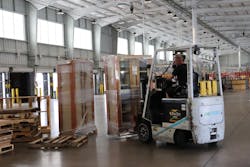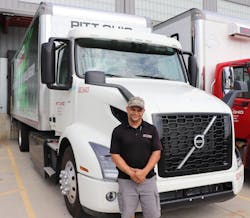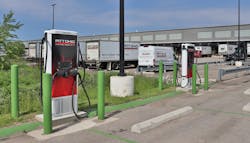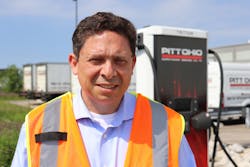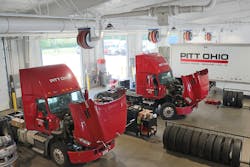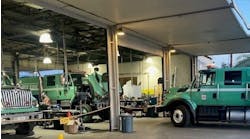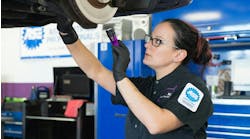PARMA, Ohio—Eight towering steel fixtures, made up of thin red cages holding spinning black and white cylinders, flank the entrance to Pitt Ohio’s Cleveland-area less-than-truckload facility. And if you didn’t know they were a new kind of wind turbine, you might write them off as some sort of abstract art. In truth, they are utilitarian monuments that not only provide renewable energy to the site's microgrid, but also herald an electrifying new chapter for trucking.
Fleet Maintenance visited Pitt Ohio’s Cleveland terminal in June to check out the fleet’s two Class 7 Volvo VNR Electric trucks, and soon found the bigger story is the LEED-certified site itself and what it means for the future of fleet facilities and overall fleet management in the age of electrification.
Seeing green
Along with those curious 60-ft. wind turbines, the site—which relocated in 2020 from one 3 miles away—includes sustainable features such as solar panels, high-efficiency lighting, geothermal heating, and office furniture and shelving made from recycled materials.
“It's a purposely built facility that's really leveraging renewables and is really green from a footprint standpoint,” said Taki Darakos, Pitt Ohio's VP of vehicle maintenance and fleet services.
For starters, there are those eight turbines, manufactured by WindStax Energy, and enough solar panels lining the terminal’s 48,115-sq.-ft. roof to generate over 500 kW of electricity per day. A patented high-voltage DC microgrid with 1 MW of battery storage was developed to effectively channel the free energy coming from the wind and sun.
“This system will generate enough electricity to power a community of 50 average U.S. households and offset 421 tons of carbon monoxide annually,” Justine Russo, Pitt Ohio's director of sustainability, said when the facility opened. “That is the equivalent to eliminating 1 million miles driven by the average passenger car every year.”
More solar panels have been added since then.
This microgrid produces more than enough renewable energy to power the entire facility and Pitt Ohio’s fleet of Volvo VNR Electrics as well as several electric forklifts. It may not always be sunny in Cleveland, but it’s rarely not windy.
According to Darakos, so much energy is produced that some of it is sold back to the local utility.
Darakos also said the facility is limited on how much it can push back into the main grid, so sections of the modular turbines will get tied off to keep from spinning and creating too much energy. As more EVs join the fleet and more chargers are added, the power demand will increase, and these artsy generators will likely be free to twist in the wind as they please. Darakos said the underground infrastructure was laid out to ensure more cabling could be easily added to facilitate more chargers.
Other sustainable highlights include the use of LED lights, geothermal HVAC on the office side and radiant heating in the standalone shop, and landscaping features and detention pond to prevent flooding and water supply contamination. Pitt estimated the office, terminal, and warehouse energy savings at around 40%, and the shop is 23% more energy efficient.
"As our business grows, so do our miles driven by Pitt Ohio trucks,” company president Chuck Hammel III recently stated. “Our increased use of renewable energy and sustainable transportation solutions is more critical than ever as we strive to reduce our carbon output.”
Pitt has six facilities in total certified LEED (4 Gold), with solar panels also at the East Windsor, Pennsylvania, site.
Pitt Ohio accrues about 9 million miles per month and runs LTL operations out of 21 facilities in the American Northeast, running 850 Class 8 trucks (mostly Freightliner, Mack, and Peterbilt, with some International and Hino mixed in), along with 600 straight trucks (Freightliner and Hino, with a few Mack MDs). This location houses 70 power units.
Two new 26-ft. VNR Electric trucks were delivered from TransEdge Truck Center in early April. They are already being put to good use, running daily pickup-and-delivery routes in downtown Cleveland.
Joel Melon, a driver with Pitt for eight years, took me on a quick drive around the lot, as he shared what he likes about the battery-electric truck. He noted the quieter operation, smoother ride, lack of diesel fumes, and power as great benefits. He added it took a little time to get used to the instant torque.
This summer, the facility will also domicile two Ford E-Transits as well. The site has two Tritium 75-kW DC fast-charging stations, located in the yard between the terminal and shop. Each can serve about 10 trucks. For now, the VNR Electrics return to base in the late afternoon and charge for about two hours.
There’s no timetable for when exactly these chargers might fill that capacity, but Darakos is just excited to start gaining more insights into the EVs’ power consumption and other relevant data.
“It's not somebody theoretically saying, ‘This is what it is,’” he said. “Now we can model it and lay out the journey.”
That path is littered with questions to answer, including at which sites are EVs a good fit, how can the fleet support them, and what the infrastructure needs and loads demands are, Darakos said.
Maintenance baby steps
For now, operating the electric trucks is a fairly simple process for Pitt. The trucks get unloaded and then plugged in by a trained dockworker. After they are fully charged, someone from operations unplugs the trucks and drives them back to the dock to get loaded up for the next day’s run, which is about 80 miles in total. Volvo touts the range up to 150 miles for this four-battery system and this straight truck’s payload at 8,800 lb. The Class 8 tractor has a six-battery version for 275 miles.
“They're coming back with probably 40% state of charge left,” Darakos said. “There are opportunities to stretch them, but we haven't done it. We're relatively early."
Darakos noted the lithium-ion batteries may degrade faster if discharged to under 20% life.
Lithium-ion batteries should last about eight to 10 years, Darakos said, adding the fleets’ electric forklifts batteries are about six years old are still going strong. An ideal diesel truck lifecycle at Pitt is about a seven to eight years or 1 million miles, so a well-maintained battery would last through the fleet’s ownership.
And Volvo does offer protection for fleets if a battery lacks the ability to hold a charge.
“We have a five-year maintenance contract that covers the maintenance and there's a very in-depth warranty that covers the battery,” Darakos said. “If it were to go below 80% in terms of its capacity then they would replace the battery, which is covered under warranty.”
EVs are still being developed, and the battery technology will likely improve in even a few years, so perhaps they will last longer. Fleets will also want to increase battery power to boost payload if these trucks are to truly replace diesel trucks. Pitt’s straight trucks normally haul between 11,000- and 15,000-lb. of freight.
“Hopefully technology and battery energy storage will improve and we can do more,” Darakos said. “Initially, we have plenty of routes and customers here that can accommodate the range up to 150 miles and a payload up to 8,800 lb.”
Another thing Darakos hopes will improve is technicians’ ability to work on EVs in this five-bay shop.
“The plan would be, like by maybe next year, to have our technicians certified at least to a certain level and have ability to do the maintenance,” Darakos said. “On the conventional side, we have a dealer code and submit warranty and do repair work."
“There will be levels and layers,” he added. “My folks here are not going to get super deep into the weeds of an EV, but they're going to be doing probably a lot more of a routine maintenance and some of the troubleshooting that they're not doing today.”
EVs don’t have aftertreatment systems, but they come with a host of potential new issues that will require certification for working on high-voltage equipment, and a strong grasp of electrical systems in general
As EVs scale up, having techs who can quickly fix issues and get these large investments back on the road will be one of the most important factors for success. If the trucks can’t run and move freight, then all that solar and wind energy goes up in smoke.
That means the fleet has to make sure the technicians they invest in for EV training actually want it and have a “genuine interest,” Darakos said.
“There could be somebody that's really competent and really sharp, but if they really don't want to go there, that would be a bad choice from the start,” Darakos concluded. “You need somebody that's willing to learn and grow, and they're going to be engaged and understand that it's not all going to be roses—and there's probably going to be some hiccups and hang-ups. This is about working through them and figuring things out.”
At this point, Pitt, like most fleets, is still figuring things out. But with a facility tailored for the future, they have a quite the head start.


